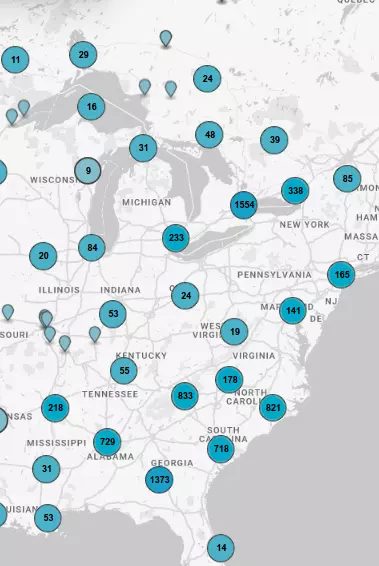The North Gate
The trail follows in the footsteps of newly arriving prisoners. Captured Union soldiers marched from the village railroad station, past this spot, and uphill to the North Gate, the main prison...
- lat34
This Was Andersonville
You are about to enter Andersonville, one of the largest Confederate prisoner-of-war camps. Of the 45,000 Union soldiers confined here, nearly 13,000 died. Erected by National Park Service. Beyond...
- lat34
Providence Spring
During a heavy rainstorm on August 14, 1864, a spring suddenly gushed from this hillside. The prisoners were desperate for fresh water, and over time the event became legendary. Several...
- lat34
Home of Samuel Henry Rumph
This house was built in 1904 as the residence of Samuel Hnery Rumph (1851- 1922), father of Georgia´s commercial peach industry. A noted horticuluturist, he originated the elberta peach at his...
- lat34
Lumpkin Academy
Horace T. Lumpkin (1857-1930) A Virginia native and son of exslaves, is credited with introducing formal education to black children in Macon County. Lumpkin, who was educated at...
- lat34
Timothy Barnard
Timothy Barnard, first white settler known to live on land now in Macon County, operated an Indian Trading Post on the west bank of the Flint River one mile southeast of here from...
- lat34
Macon County
This County, created by Act of the Legislature Dec. 14, 1837, is named for Nathaniel Macon of North Carolina, President Pro-Tem of the U.S. Senate. The first County Site at Lanier was moved to...
- lat34
Ashantilly
Built ca. 1820, Ashantilly was the mainland residence of prominent antebellum planter Thomas Spalding (1774-1851), owner of the nearby Sapelo Island Plantation. The house, likely built...
- lat34
Sapelo Island
Situated five miles to the east, Sapelo was home to Native Americans four thousand years ago and was the site of a sixteenth-century Franciscan mission. Thomas Spalding was a leading planter...
- lat34
Port of Darien
Situated ten miles from the Atlantic near the mouth of the Altamaha River, Darien attained prominence as a seaport in the 1820s. Rice and upland cotton from Georgia´s interior were shipped from...
- lat34
The Burning of Darien
On June 11, 1863 the seaport of Darien was vandalized and burned by Federal forces stationed on nearby St. Simons Island. The town was largely deserted, most of its 500 residents having...
- lat34
Darien's Railroad and Depot
In 1889 the Darien Shortline Railroad was organized to transport yellow pine timber to the Darien sawmills from Georgia´s interior. Originating in Tattnall County and continuing through Liberty...
- lat34
William Bartram Trail Traced 1773-1777
Donald McIntosh welcomed William Bartram to his home in 1773, giving him shelter from ´A Tremendous Thunderstorm.´ Erected by McIntosh Family Cemetery Association in cooperation with Oleander...
- lat34
Oglethorpe Oak 1736
Traditional site of Oglethorpe´s Shelter in 1736 upon occasion of his visit to Darien, a town founded that year by Scotchmen under his direction. Atlantic Coastal Highway Commission Marker -...
- lat34
1836 Methodists At Darien
John Wesley, founder of Methodism, spent January 2 & 3, 1737, among the Scots in Darien, where he first prayed extempore. In 1836 after many efforts, circuit riders aided by layman...
- lat34
Birthplace of John McIntosh Kell
Laurel Grove, at the end of this avenue, was the birthplace of John McIntosh Kell, 1823-1900, distinguished Naval officer. He was a member of the expedition of Commodore Matthew C. Perry to Japan...
- lat34
Sutherland's Bluff
--- 1.5 mi. --> Sutherland´s Bluff, about 1.5 miles South on this road, overlooks the Sapelo River and the inland Waterway. the site was named for Lieut. Patrick Sutherland, to whom it...
- lat34
Old Belleville or Troup Cemetery
Within these walls are buried Captain Troup, British Naval officer, and his wife, Catherine McIntosh Troup. They were the parents of George M. Troup, Governor Georgia 1823-1827; U.S....
- lat34
Capture of 23 Old Men in 1864
Near here, in Ebenezer Church, 23 old men were captured by Federal troops on the night of August 3rd, 1864. These civilians, too old for military service, were the sold protection of...
- lat34
Confederate Post in 1864
Near this spot, Company F of the Third South Carolina Cavalry, Lieut. W.L. Mole commanding, was stationed during the summer of 1864. The Company was on Patrol duty, guarding the Coast of...
- lat34
